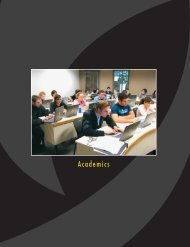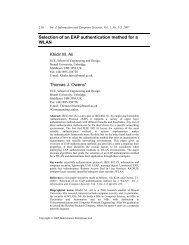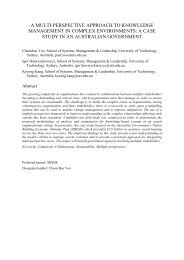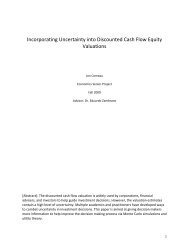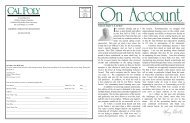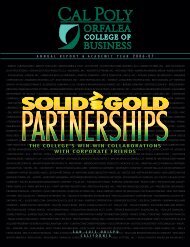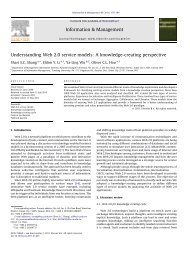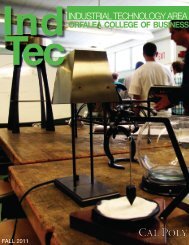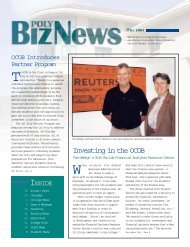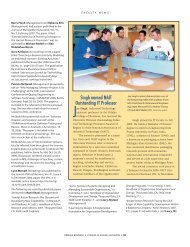OCOB Ann Rep 07-08 - Orfalea College of Business - Cal Poly San ...
OCOB Ann Rep 07-08 - Orfalea College of Business - Cal Poly San ...
OCOB Ann Rep 07-08 - Orfalea College of Business - Cal Poly San ...
You also want an ePaper? Increase the reach of your titles
YUMPU automatically turns print PDFs into web optimized ePapers that Google loves.
FACULTY REPORTSExplaining World TradeBY KATHRYN G. MARSHALLASSISTANT PROFESSOR OF ECONOMICSThe growth <strong>of</strong> global trade in the last several decades <strong>of</strong>fersan exciting area <strong>of</strong> research for economists. Nocountry better illustrates the potential for trade thanChina, which is now one <strong>of</strong> the largest trading countries inthe world. Since coming to <strong>Cal</strong> <strong>Poly</strong> in 20<strong>07</strong>, my researchin collaboration with <strong>Cal</strong> <strong>Poly</strong> Pr<strong>of</strong>essor Eric Fisher hasfocused on theoretical and empirical methods to betterunderstand the driving forces <strong>of</strong> world trade, and I have appliedthese new ideas to help explain China’s remarkabletrade growth. In this article, I will sketch the main features<strong>of</strong> this research and highlight some significant findings.Input Output AnalysisTo understand the pattern <strong>of</strong> international trade, onemust first look carefully at the structure <strong>of</strong> productionwithin each country. Economist Wassily Leontief pioneeredthe use <strong>of</strong> the input output table in the 1940s tomodel the intricate linkages between different industries ina modern economy. Each industry or sector in an economyproduces goods which are in turn used as intermediate inputsin the production <strong>of</strong> other products. When we measuregross domestic product (GDP), we capture only the finalstage in that complex production process. For example, inthe U.S. economy, the production <strong>of</strong> one dollar’s worth <strong>of</strong>output in the automotive sector requires about $0.03 worth<strong>of</strong> products produced in the rubber and plastics sector andabout $0.05 worth <strong>of</strong> iron and steel products. In total, about$0.76 per dollar <strong>of</strong> intermediate inputs from all sectors <strong>of</strong>the U.S. economy goes into the production <strong>of</strong> automobiles.The remaining $0.24 per dollar <strong>of</strong> automobile productionmeasures the most important component in any productionprocess: value-added. To a business pr<strong>of</strong>essional,value-added is better known as pr<strong>of</strong>its (paid to the owners<strong>of</strong> capital) and wages (paid to workers). Economists callthese two special inputs, capital and labor, factors <strong>of</strong> production.In the automotive example, the $0.76 worth <strong>of</strong> intermediateinputs is itself produced by workers and capitalin other sectors, sectors which in turn use intermediateinputs combined with the services <strong>of</strong> workers and capitalto produce output. While this may seem like an infiniteregression, a simple mathematical technique converts thedollar value <strong>of</strong> any final product into payments to capitaland labor used directly to produce that product and indirectlyto produce all the intermediate inputs that went intothe product. For the U.S. automotive industry, when thisfull accounting is undertaken, each dollar’s worth <strong>of</strong> automobileproduction amounts to a payment <strong>of</strong> $0.31 to owners<strong>of</strong> capital and a payment <strong>of</strong> $0.69 to workers throughoutthe economy. Labor intensive industries are defined as industrieswith a higher payment share to labor.Two different economies can be readily compared usinginput output tables. Thanks to the efforts <strong>of</strong> the Organization<strong>of</strong> Economic Cooperation and Development(OECD), detailed and consistent input output accounts areavailable for many countries <strong>of</strong> the world. To compare theU.S. and Chinese economy, Table 1 summarizes these detailedaccounts into four major sectors – agriculture, mining,manufacturing, and services. I have also added data onemployment in each broad sector taken from the InternationalLabor Office.The most notable feature <strong>of</strong> the Chinese economy isthe huge labor force <strong>of</strong> around 721 million workers, equalto about five times the size <strong>of</strong> the U.S. labor force. But noticealso the disparity in wages across sectors. Overall, theU.S. average wage is about 19 times higher than the Chineseaverage wage. This is a clear indication that the productivity<strong>of</strong> labor is different in these two economies. U.S. workersTable 1: A Comparison <strong>of</strong> the U.S. and Chinese economies in 2000USAAgriculture Mining Manufacturing Services TotalPayments to Capital ($ billions) 71 71 496 2,985 3,624Payments to Labor ($ billions) 32 38 948 5,176 6,193Employment (millions) 3 1 20 111 135Average Wage $ 9,223 $72,204 $ 47,558 $46,505 $ 45,806ChinaAgriculture Mining Manufacturing Services TotalPayments to Capital ($ billions) 44 83 496 446 1,069Payments to Labor ($ billions) 416 59 561 737 1,773Employment (millions) 334 6 80 301 721Average Wage $ 1,248 $ 9,811 $ 6,978 $ 2,448 $ 2,459ORFALEA COLLEGE OF BUSINESS ❚ 21



